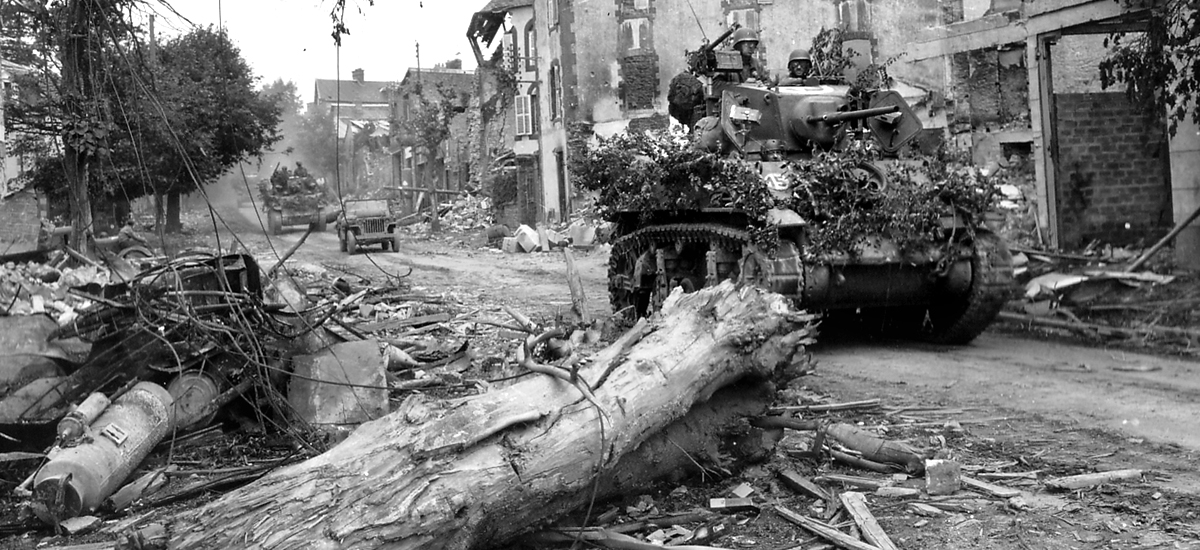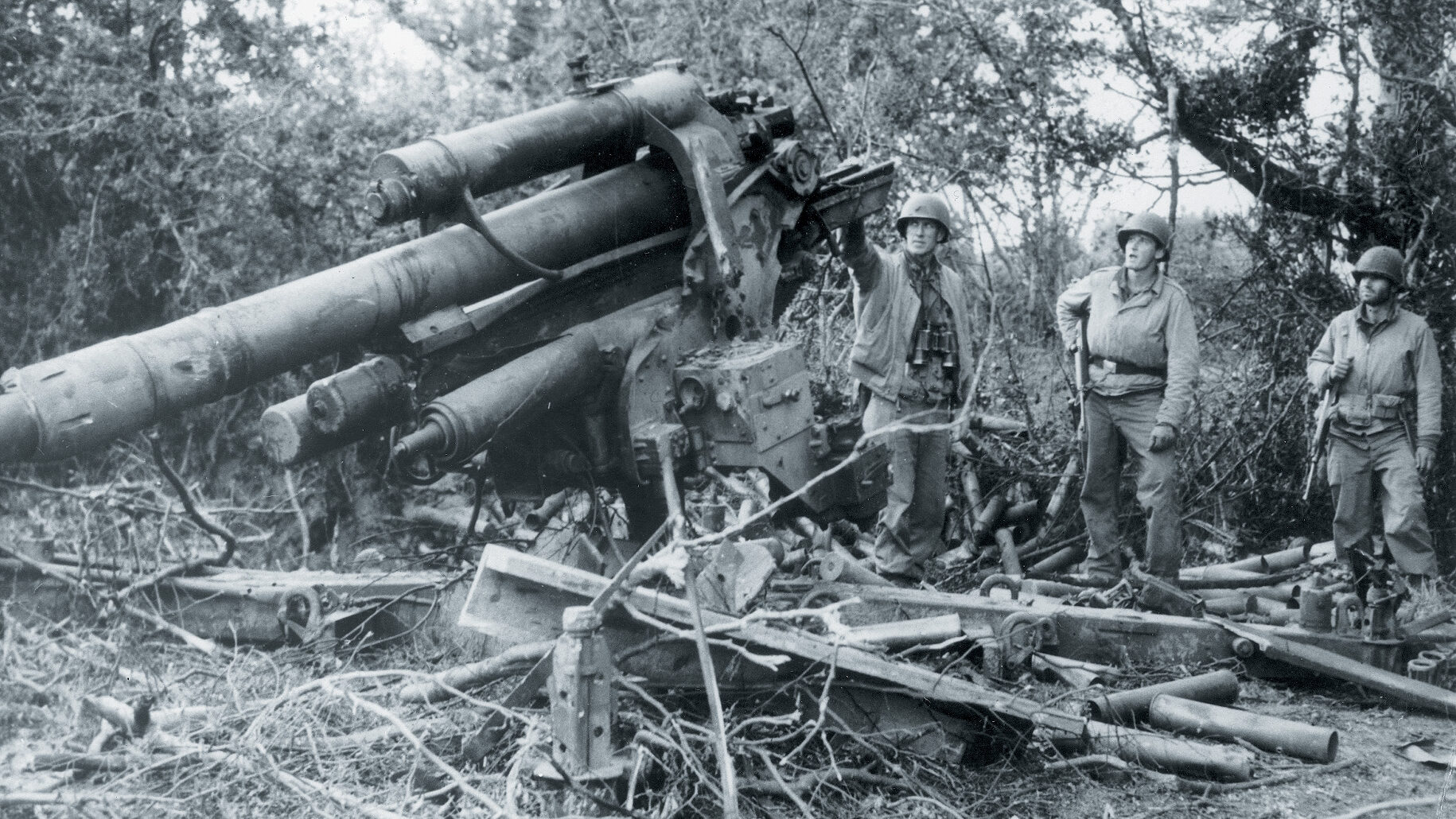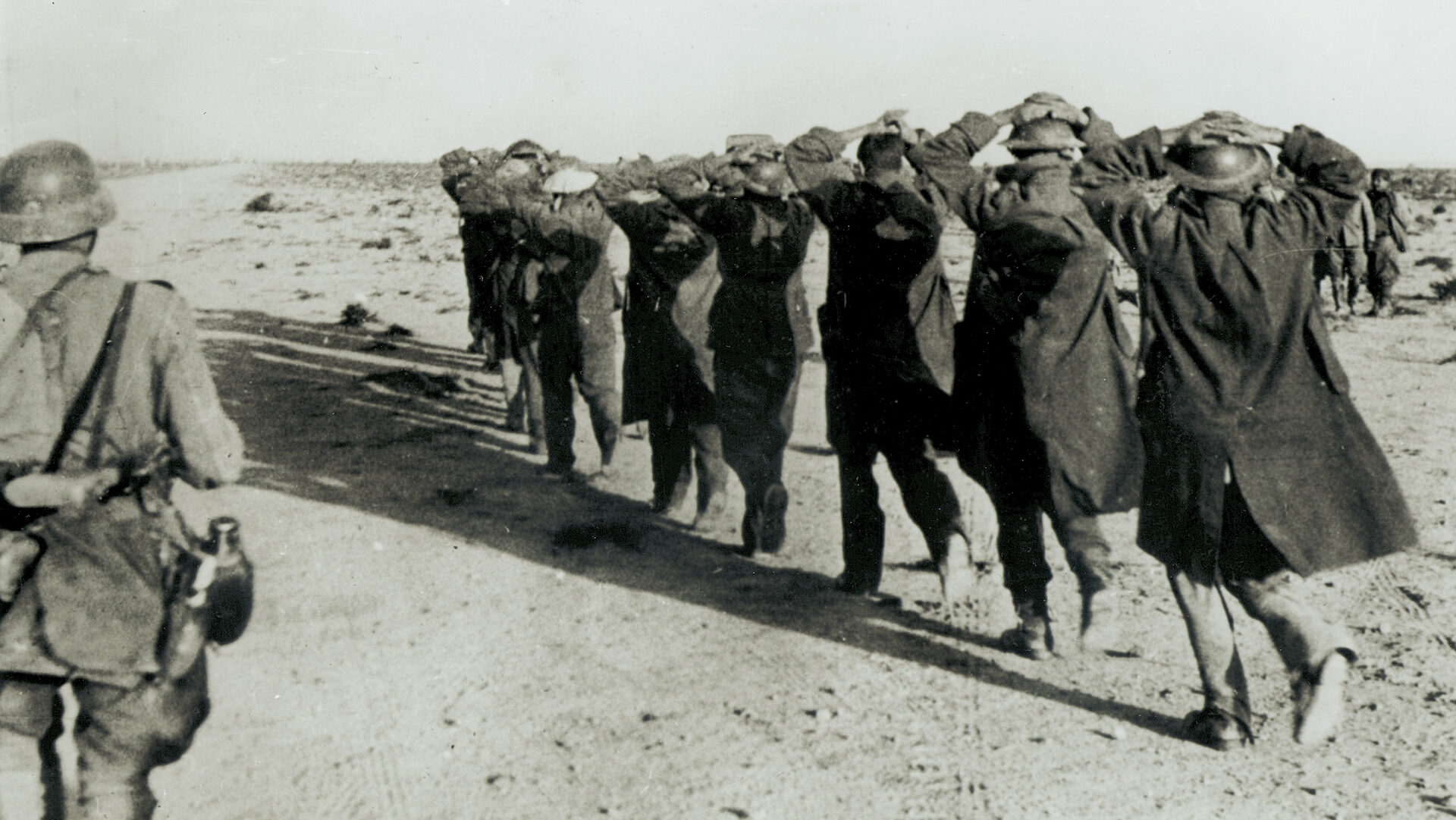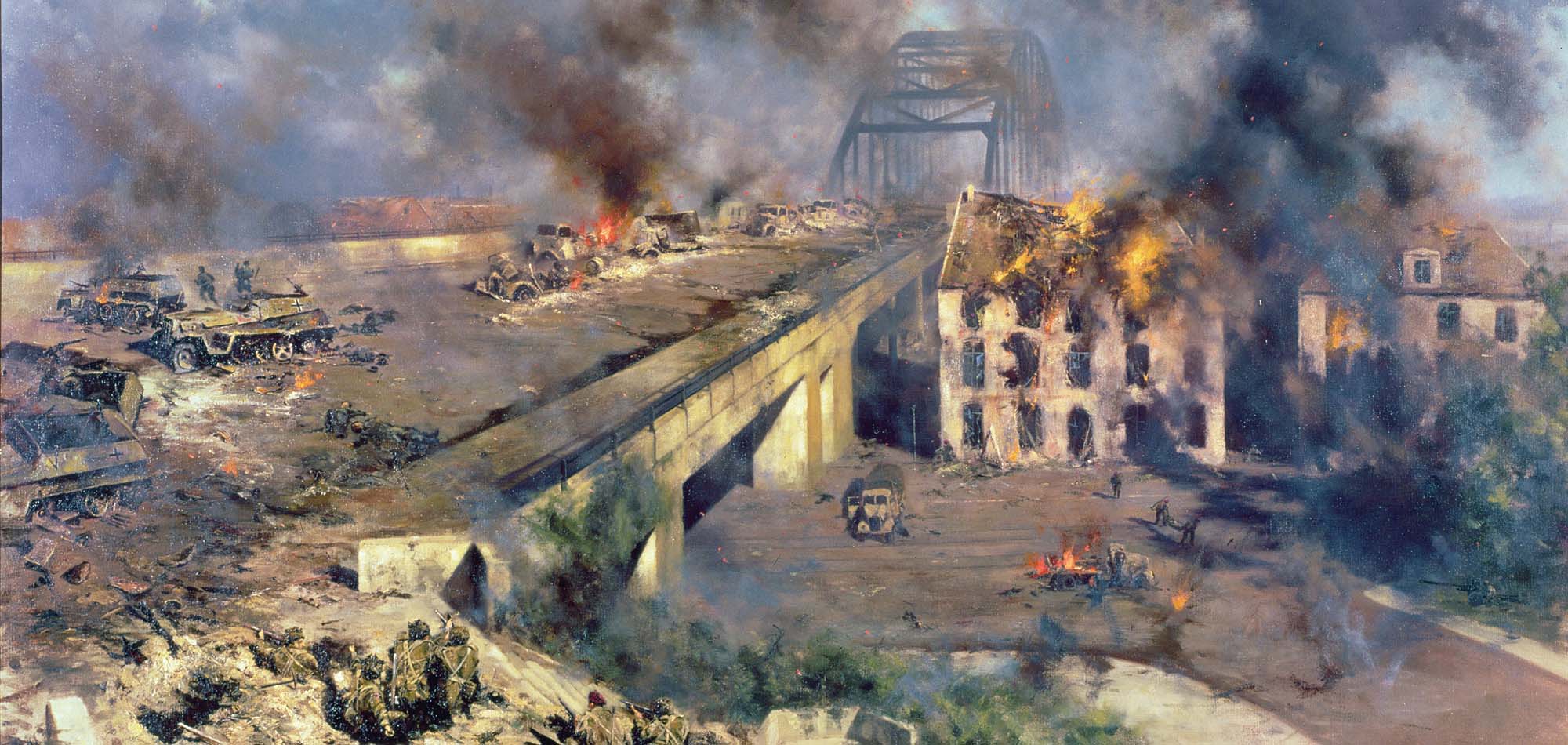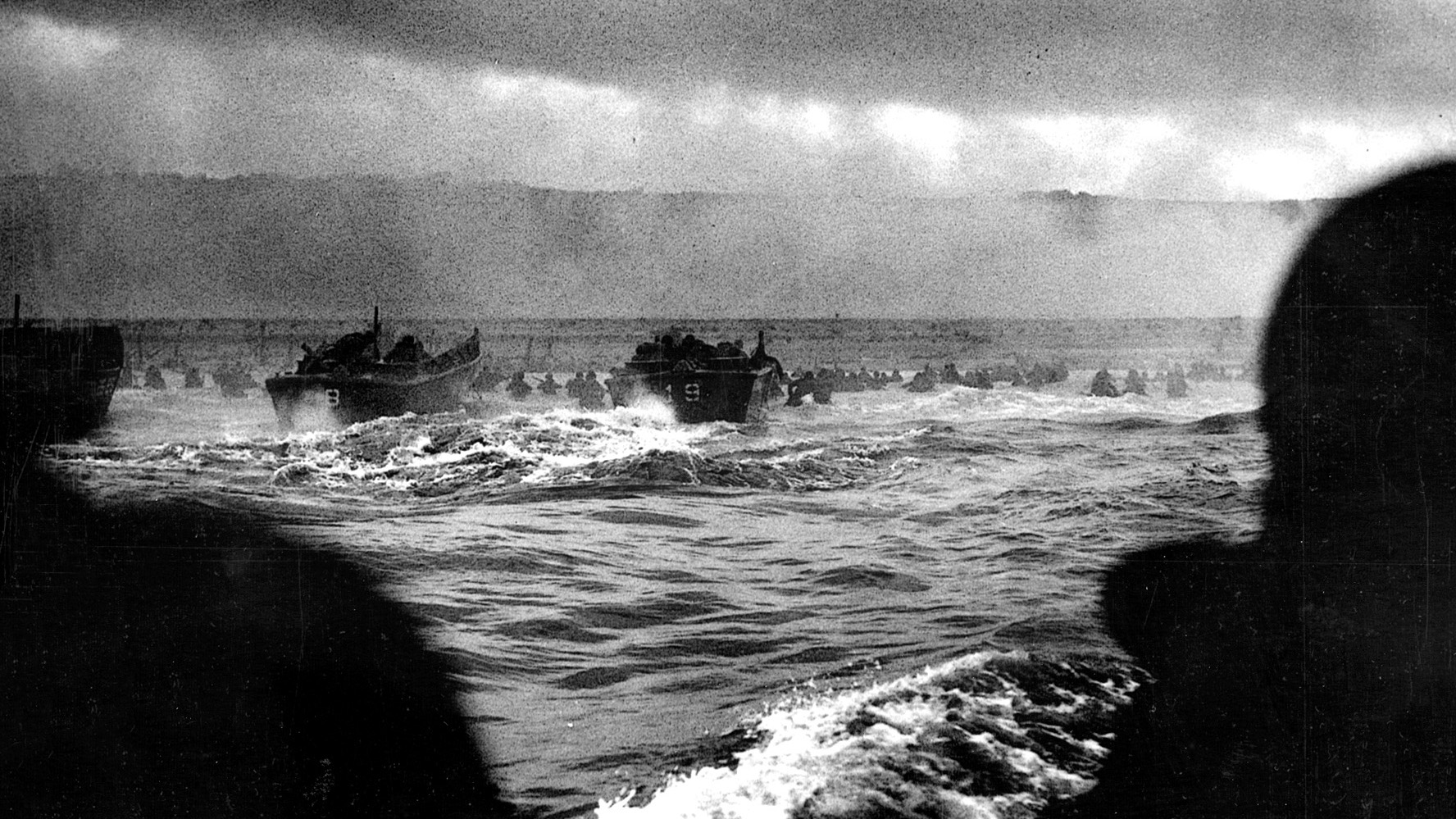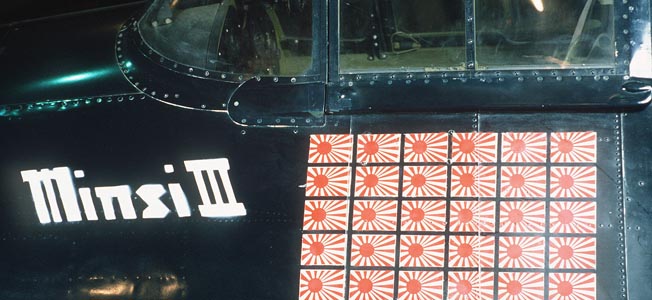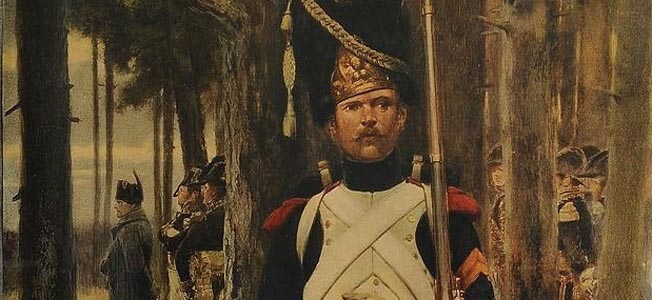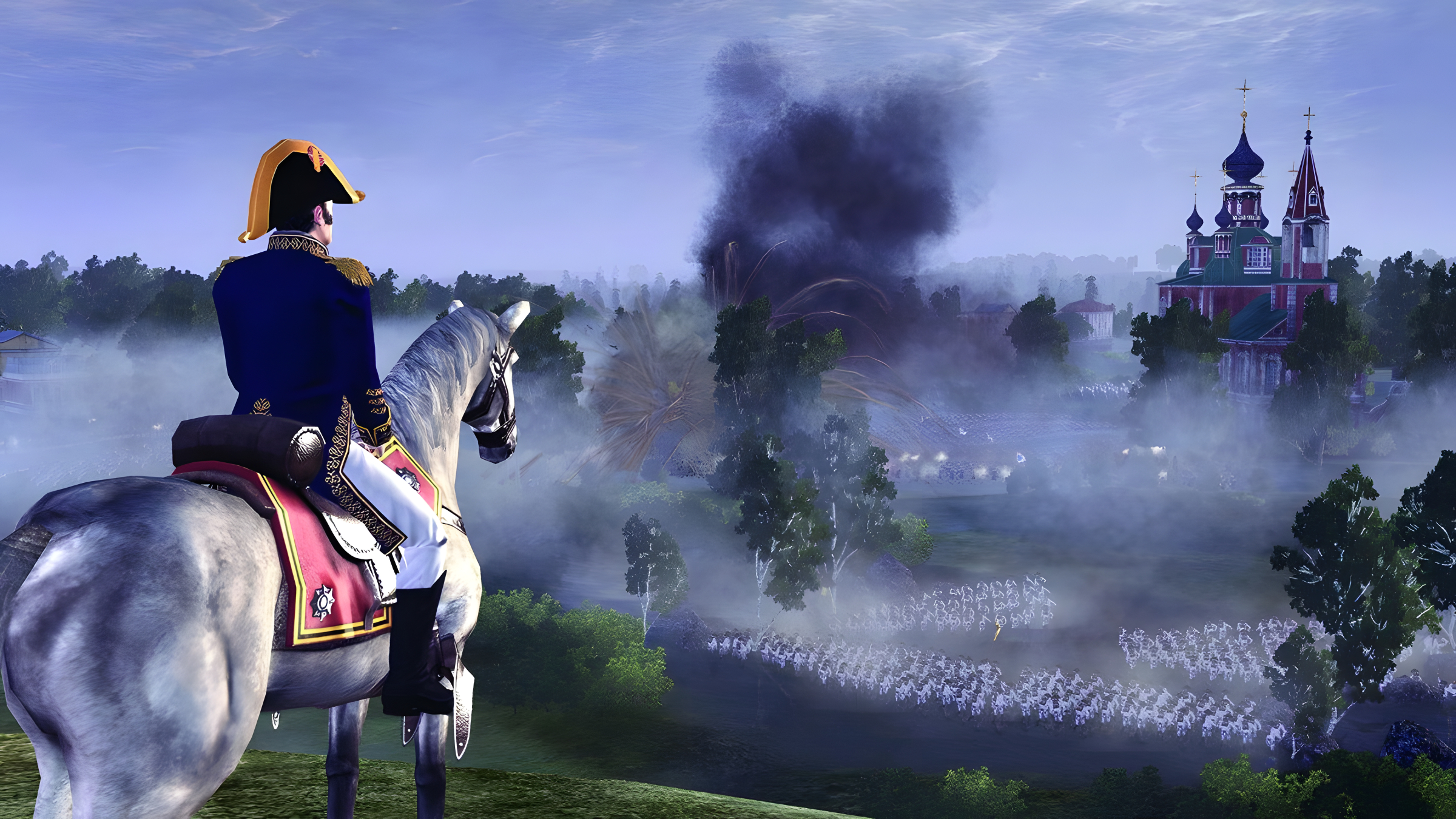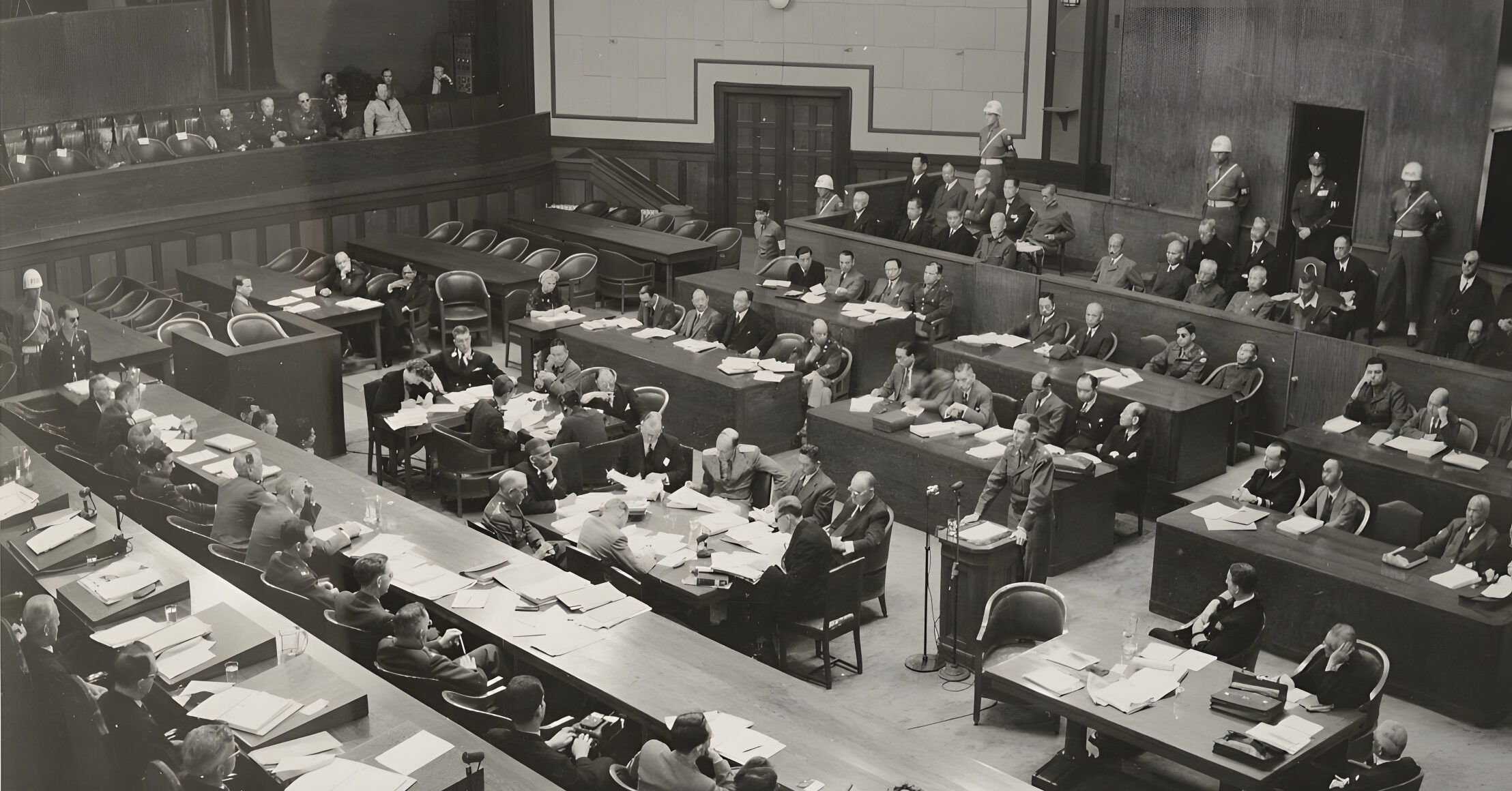By Patrick J. Chaisson
Company B’s jeeps, armored cars, and self-propelled guns stood lined up on a narrow road, their crewmen anxious to move out. Up ahead, they had heard, another reconnaissance unit had met stubborn German resistance and needed help.
Blocking their way, however, was a Mk.V tank. None of the Americans’ light weapons would be able to batter through its armored hide, so to get around the leviathan, the GIs would have to rely on speed and surprise.
One by one, Company B’s vehicles took off down the road at full throttle. Zipping by the panzer at 50 miles per hour, truck after truck passed through its kill zone unscathed. Then one last machine, an M8 self-propelled assault gun, got caught in what witnesses later called “a shooting gallery.” A high-velocity 75mm shell struck the M8, instantly killing three of its five crewmen: Sergeant Dallis A. Drake, Pfc. Charles S. Duncan, and Pfc. Hubert G. Roberts.
The panzer, however, had revealed its position. Within minutes, four American Republic P-47 Thunderbolt fighter-bombers pounded it into a smoking wreck. Next, a low-flying observation plane buzzed the area to confirm that the way forward was clear once again.
At the cost of three lives, Company B of the 82nd Armored Reconnaissance Battalion had pierced the foe’s thick defensive crust. This aggressive unit’s foray deep behind enemy lines during the last days of July 1944 helped launch the Allied breakout in France.
Yet these veterans knew better than to underestimate the Germans, dangerous opponents even in retreat. Troopers of the 82nd Recon expected to encounter many combatants desperate to flee the trap being closed around them. Both sides would soon meet in a number of headlong clashes, all distinguished by their suddenness and savagery.
For five weeks following the Normandy invasion of June 6, 1944, Lt. Gen. Omar N. Bradley’s First Army slogged its way through a thickly vegetated region of impenetrable hedgerows and sunken lanes known as the bocage. In this difficult terrain, Bradley’s forces gained on average one mile per day while suffering heavy casualties inflicted by skilled, resolute defenders.
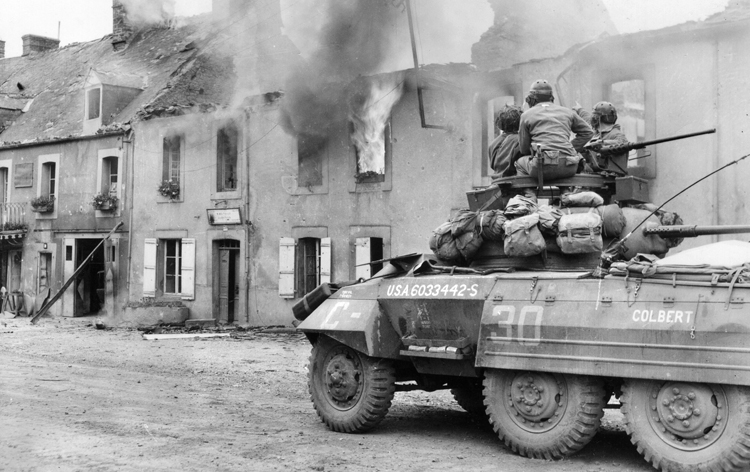
First Army needed to punch through the bocage and onto terrain better suited for its rapidly maneuverable motorized forces. Bradley’s breakout plan called for concentrated aerial bombardment to blast a gap in the lines, followed immediately thereafter by coordinated infantry and armored attacks. He codenamed this scheme Operation Cobra and assigned it to his most aggressive commander, Maj. Gen. J. Lawton “Lightning Joe” Collins.
Collins had performed brilliantly as VII Corps chief during the Utah Beach landings. He had also orchestrated the speedy capture of Cherbourg, a heavily fortified port city on Normandy’s northern coast. His corps now faced south, in the center of the U.S. line.
Throughout mid-July, Bradley and Collins worked to refine their plan. Operation Cobra was to kick off once other First Army units seized the crossroads town of St. Lo, thereby clearing the way for VII Corps’ advance. After Allied aircraft saturation-bombed a narrow corridor west of town, Collins’ infantrymen would take and hold open the penetration’s shoulders. Then, strong mechanized columns would roll in behind the foe and cut off his retreat.
Unfortunately, bad weather and worse luck plagued Cobra’s initial stages. Twice, on July 24 and 25, several squadrons of U.S. Army Air Force bombers accidentally dropped their loads on friendly troops. Among those killed was Lt. Gen. Lesley J. McNair, commander of the phantom First Army Group.
The VII Corps’ riflemen encountered vicious return fire when they finally started their movement through the impact area on July 25. Somehow, numerous enemy emplacements had escaped untouched by the preparatory barrage, blocking the Americans from achieving Cobra’s first-day objectives.
In VII Corps headquarters, though, there was cause for careful optimism. True, Maj. Gen. Collins noted, their infantry assault stalled early. But neither did the Germans launch an immediate counterthrust, something for which they were notorious. “Lightning Joe” believed Cobra’s massive air strikes damaged his opponents far more than what initial reports had indicated.
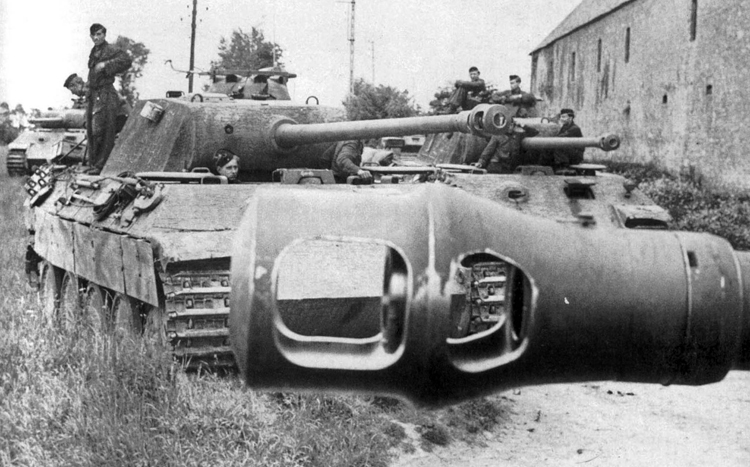
Collins was correct. These concentrated bombings had killed many soldiers and obliterated many vehicles and fortifications, burying them underneath a carpet of rubble. Those men who survived the attacks were mostly so dazed as to be combat ineffective. The bombing had also destroyed telephone and radio systems, crippling German commanders’ ability to monitor and influence the battle.
The German Seventh Army’s commander, SS Obergruppenführer (Lt. Gen.) Paul Hausser, was struggling to obtain a clear picture of the tactical situation. It seemed the Americans had punctured his lines west of St. Lo in the sector held by the Panzer Lehr Division right on the boundary between the II Parachute Corps and LXXXIV Army Corps. Messengers told him of U.S. tanks already operating well inside the Seventh Army rear area.
Leading this onslaught was the 82nd Armored Reconnaissance Battalion. Known as “the commander’s eyes and ears,” the 82nd Recon ranged deep into enemy territory to locate defensive positions and troop concentrations, evaluate routes, and report all observed activity. While lightly armed in comparison to a tank battalion, the outfit could for a limited period hold key objectives such as bridges or road junctions.
The battalion was organized into a headquarters and service company, three reconnaissance companies, a light tank company, and a medical detachment. Each recon company fielded 15 M8 armored cars, 16 quarter-ton gun jeeps, three M8 75mm assault guns, and five half-tracks. Their arsenal also included 60mm mortars for indirect fire and illumination missions. The light tank company had on hand 17 M5A1 Stuart tanks, whose 37mm guns were employed mainly against soft-skinned vehicles, bunkers, and personnel.
Although similar in mission and equipment to a cavalry squadron, the unit retained traditional battalion and company designations because its parent unit, the 2nd Armored Division, was established under a prewar authorization document.
Commanded by Lt. Col. Wheeler G. Merriam, the 82nd Armored Reconnaissance Battalion had assigned 51 officers and 851 enlisted soldiers. One of those troopers was a no-nonsense career cavalryman named Victor S. Prawdzik, the outfit’s senior NCO and sergeant major, whom, battalion lore said, the enlisted men feared more than the Germans.
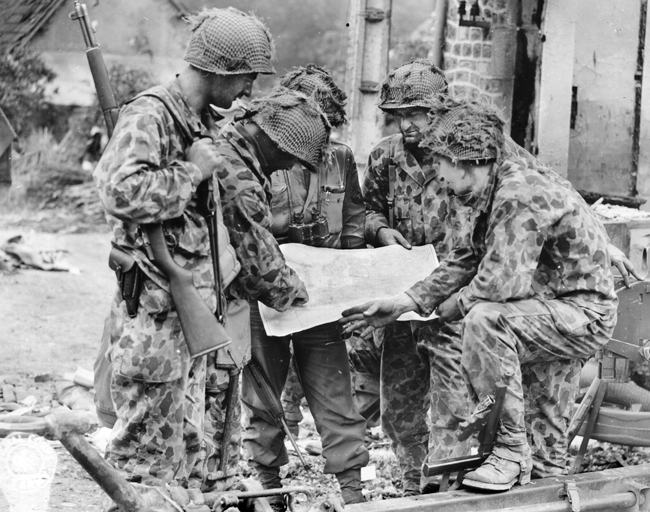
The 82nd Recon came ashore at Omaha Beach on June 10, 1944, but stayed mostly in reserve for the next five weeks. Busting the bocage was an infantry fight, and the 2nd Armored required open ground on which to wage its style of mounted warfare. Meanwhile, the recon troopers kept busy training replacements and maintaining their equipment.
Lieutenant Colonel Merriam received the operations order for Cobra late on July 25. This plan directed his men to conduct a zone reconnaissance up to the deep-banked Seine River, where they were to demolish a set of bridges in order to block the German retreat. The battalion would also provide flank security, furnish connecting patrols, and maintain contact with adjacent outfits. H-hour had been set for 0430 hours on Thursday, July 27, 1944.
Following directly behind the 82nd Recon was Combat Command B (CCB) of the 2nd Armored Division, led by Brig. Gen. Isaac D. White. This powerful mechanized organization consisted of the 1st and 2nd Battalions, 67th Armored Regiment (totaling 118 medium M4 Sherman and 34 light M5A1 Stuart tanks), the 1st and 3rd Battalions, 41st Armored Infantry Regiment (1,400 riflemen and 122 halftracks), the 78th Armored Field Artillery Battalion (520 gunners and 18 M7 105mm self-propelled howitzers), plus the usual signal, service, and support elements. The 17th Armored Engineer Battalion, less one company attached to Lt. Col. Merriam’s 82nd Recon, also joined this task force.
White’s mission called for aggressiveness and maximum flexibility. Once inside enemy-held territory, his armored columns would move rapidly to the southwest and secure a line of objectives designed to prevent German reinforcements from moving northward into the American lodgment.
Several small communities marked their route of advance. After passing through VII Corps lines at Canisy, CCB was to roll through Quibou, Dangy, Notre-Dame-de-Cenilly, Saint-Denis-le-Gast, Lengronne, and lastly to the Seine River bridges near Cerences. At each crossroads, bridge, and hilltop, small detachments would drop off to establish blocking positions.
One macadam-surfaced road supported the attack. Numerous farmers’ fields, sunken lanes, and thick hedgerows lined the route, while several crisscrossing streams further hampered mobility. While the weather had recently turned sunny after a month of almost constant rain, many unimproved side roads remained wet and impassable.
Army intelligence possessed a limited understanding of the enemy situation. The VII Corps leadership believed that Panzer Lehr, or what was left of it, sat directly in CCB’s path, while another five German divisions held positions to the north. Many of these units, however, were now significantly understrength after six weeks of near-constant fighting.
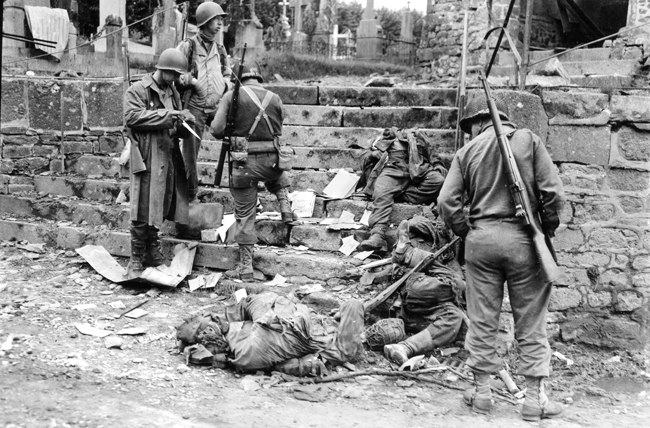
Well before dawn on July 27, a long column of olive drab vehicles began assembling along the road near St. Jean de Daye. Right on time, the 82nd Recon stepped off with Company A in the lead as advance guard, accompanied by a platoon of armored engineers. Company B, with another engineer platoon attached, was directed to scout the primary route of movement. Next in line was Company C, with orders to move north of the main line and keep in touch with friendly forces on CCB’s flank. The light tanks of Company D headed up the rear, followed by battalion headquarters and a rear security element.
Watching over the reconnaissance scouts were a number of nimble but completely unarmed spotter aircraft flown by pilots assigned to the 2nd Armored Division Artillery. Flying out ahead of the armored column, these “Maytag Messerschmitts” (one nickname for the lightweight liaison planes) could both provide early warning to ground commanders and request immediate close air support in the form of P-47 Thunderbolts from U.S. IX Tactical Fighter Command. Air liaison officers riding with the 82nd Recon were also in contact with these flights of fighter-bombers, standing by to destroy the deadliest targets.
Traffic congestion, made worse by heavily cratered roadways, initially slowed the attack force’s progress. Once past Canisy, though, the column picked up speed. The first objective: Quibou, one and a half miles distant.
Just outside that tiny hamlet, Company A encountered the Panzer Lehr Division. Here, 16-year-old radioman Private William A. “Chicken” Nawrocki’s jeep took a wrong turn and blundered into a German tank. While two fellow GIs managed to run off amid the confusion, Nawrocki saw that he was cornered. Wisely, he raised his hands in a sign of surrender.
Not far away, Private Carl Wood’s armored car came face to face with another panzer. Its crew, Wood recalled, “were as surprised as we were and they immediately started getting inside to position their 7.5 [cm cannon] and to fire on us at point blank range.” Driver Francis O’Neill immediately shifted into reverse and “moved rapidly, faster than I ever dreamed that anyone could drive one of these armored cars backwards.”
Wood’s vehicle escaped unharmed, but this Mk.V later destroyed Sergeant Drake’s Company B assault gun while it was attempting to run through the line of fire. That incident caught the attention of four P-47s orbiting overhead; after a quick radio call, the warplanes swooped down to attack. “They came in with the bombs at about 1,000 feet,” Wood wrote later. “It was to the back of us, and it seemed like we had to duck, they came in so low.”
The Thunderbolts made short work of their prey, extracting a measure of revenge for those three Americans and their assault gun lost earlier.
Moving cross-country, Company B also ran into German armor north of Quibou. First Platoon, under 1st Lt. James J. O’Connor, spied the captive Nawrocki lying spread-eagled on the front deck of a panzer. While O’Connor’s crews distracted the enemy tankmen with machine-gun and 37mm cannon fire, Nawrocki managed to slip away. The lucky ex-prisoner was later evacuated for medical treatment.
Bypassing pockets of resistance for CCB to mop up, the recon men had by 1100 hours moved forward another two and a quarter miles to the village of Dangy. In the lead armored car was 1st Lt. Danford Bubolz.
“There was some firing going on as we entered the village,” Bubolz recollected. “One German fired at me from a doorway about 20 feet from my left side and put a hole through the neck of my jacket, but he missed because he did not allow for the movement of my vehicle. I ducked down into the turret and then came up again with my .45 pistol and slammed a couple rounds into the doorway, forcing him back in.”
A sergeant from the next armored car in line killed the troublesome German soldier as they rolled by. Altogether that afternoon, troopers destroyed five half-tracks, a tank, several wheeled vehicles, some horse-drawn supply wagons, and one 1935 Buick repurposed as an ambulance. Unfortunately, Dan Bubolz received severe wounds to both legs when a truck loaded with land mines exploded as he was attempting to clear it off the road.
The 82nd Recon pronounced Dangy secure at 1500 hours. Colonel Merriam then received a radio message from the 2nd Armored Division’s command post: “Speed up.”
CCB’s rapid gains had prompted a change in mission. “Lightning Joe” Collins now believed Brig. Gen. White’s combat command could cut the foe’s route of retreat and ordered him to drive for the coast. It was a big job, especially since the Germans had gotten a head start. Only a hell-for-leather advance would ensure the Americans won this race.
Company B’s jeeps, assault guns, and armored cars soon roared off for Pont Brocard, just two miles down the road. Along the way, they passed a nondescript farmhouse that happened to be the Panzer Lehr Division’s command post. From inside, its commander, Lt. Gen. Fritz Bayerlein, watched these reconnaissance vehicles speed by. How, Bayerlein asked his staff, did American soldiers get this far behind our lines so quickly?
The German officers did not have much time to ponder his question, though. Moving closely behind Company B was a phalanx of M4 tanks, CCB’s advance guard. While the recon scouts often held their fire on the move as a way of preserving stealth, CCB’s tankers felt no such reluctance to expend ammunition. Identifying the farmstead and its collection of command cars parked outside as a lucrative target, they sent shell after shell into it. Diving out a window to make his getaway, Bayerlein escaped alone into the gathering darkness.
Merriam’s battalion had by midnight made it to Notre-Dame-de-Cenilly, more than seven miles from its starting point. Once past Panzer Lehr’s few remaining strongpoints, his fast-moving troopers now faced mostly an assortment of astonished rear echelon personnel and the odd combat outfit caught attempting to retreat. The attached engineer company, for example, captured 32 soldiers and several horse-drawn artillery pieces that stumbled into its bivouac position after dark.
That evening, the recon men “coiled up” (i.e., established a night defensive perimeter) in the fields surrounding Notre-Dame-de-Cenilly. While tired soldiers stood watch or grabbed a few hours of sleep, headquarters personnel on both sides labored into the wee hours.
Staff officers at 2nd Armored’s command post hustled to send forward reinforcements. They eventually released the division reserve, plus a spare infantry battalion, to buttress CCB’s hastily established strongpoint defense. It was also decided that Merriam’s unit would resume its original mission of blowing up bridges along the River Seine.
German Seventh Army headquarters also hummed with activity. General Hausser saw his command was about to become torn in two, but extremely poor communications prevented him from doing much to prevent this disaster. Before the phone lines went out, Hausser directed all combat divisions west of St. Lo to commence a fighting withdrawal.
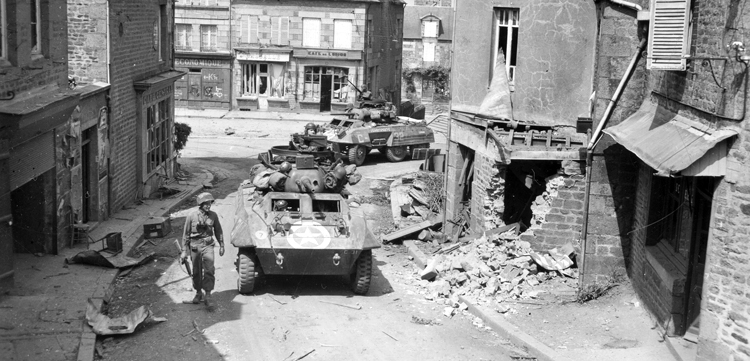
His planned line of retreat, however, brought those outfits straight up against the 2nd Armored Division’s strongest roadblocks. Hausser finally realized his mistake, but by then the damage had been done. Many German formations were already on the move and could no longer be contacted by telephone, radio, or messenger.
As all land lines were still down, Hausser felt he had to personally issue new, correct withdrawal orders to the Seventh Army commanders most threatened by this attack. At dawn on July 28, he set out by car to meet those officers, but he never made it.
Later that morning near Lengronne, a patrol from Company C, 82nd Recon, fired on Hausser’s staff car as it drove into view. Had the U.S. gunners known who was inside that vehicle they would surely have ensured its destruction; as things stood, getting to the Seine bridges had a higher priority than finishing off a fleeing automobile. Hausser got away, having learned for himself just how far the recon troopers had penetrated the Seventh Army’s rear area.
It was now Company C’s turn to lead the dash, with two borrowed M4 tanks out front. Third Platoon Leader 2nd Lt. Morton C. Eustis fought from the back deck of one Sherman, “mowing down Jerries with a .50 caliber machine gun,” as he later wrote his mother.
Another Company C lieutenant “raising merry hell” that day was Merle A. Hanson. His scout section fell upon a huge fuel dump near Cerences, scattering its defenders before destroying 20,000 gallons of precious gasoline with thermite grenades. “Our C Company had captured, killed and wounded 130 men,” Lieutenant Hanson claimed of the afternoon’s activity. “We had shot up at least 30 trucks and small vehicles, and made many French peasants very happy when we broke the German hold on their countryside.”
Hanson also remembered how those villagers’ joyous expressions disappeared once they observed Company C withdrawing from its river outposts later that afternoon. The American advance had halted, and now U.S. commanders were working to prepare their overextended units for likely collisions with large numbers of well-armed, organized enemy soldiers all bent on escape. At 1800 hours, Lt. Col. Merriam drove out to personally order his far-flung recon companies back to their bivouac positions near Notre-Dame-de-Cenilly.
While Merriam was out coordinating his defense, a band of retreating German foot soldiers struck the 82nd Recon’s command post. Organized by Sergeant Prawdzik, the normally noncombatant drivers, radio operators, code clerks, and cooks all grabbed their individual weapons and hurried into position along a hedgerow. Walking behind the GIs, Prawdzik encouraged them by repeatedly hollering, “Get a move on, trooper, get a move on!”
By the time Lt. Col. Merriam returned, the attack had already been repelled with some help from Company D’s light tanks. “It was reassuring to know that the men thought less of the enemy than the sergeant major’s wrath,” Merriam observed wryly before returning to the business of commanding his battalion. Already, the recon companies were reporting heavy fighting near a crossroads known as La Pinetiere.
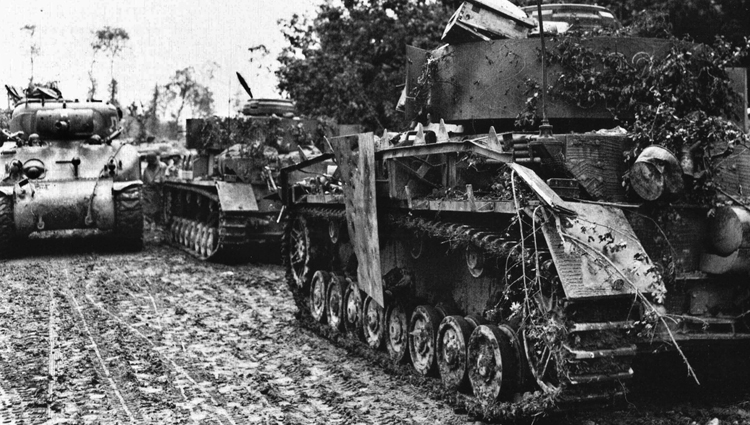
This intersection a mile southwest of Notre-Dame-de-Cenilly became the scene of a fierce encounter between German and American forces that began before dawn on Saturday, July 29. After sunrise, 15 tanks and 250 Fallschirmjäger (paratroopers) smashed into the U.S. perimeter there. Among CCB’s defenders at La Pinetiere were two batteries of field artillery, a pair of antiaircraft half-tracks, and one big recon trooper.
Private Robert Lohr of Company C, 82nd Armored Reconnaissance Battalion, stood 6 feet, 4 inches tall and weighed 240 pounds. The burly Californian easily carried his Browning Automatic Rifle and 27 magazines full of ammunition; that morning he would need all of them. Taking cover in a treeline, Lohr opened up on the shadowy figures of advancing paratroopers.
“Normally I fired in only groups of two or three,” he remembered. “But, with many targets, I shifted to rapid fire and would start at the left, go through a magazine and insert a new one, and go back to the left again.” Then Lohr took what he called “a massive blow to my chest.” Although seriously injured, he survived to eventually receive a Silver Star and French Croix de Guerre for his role in defeating the assault.
After reinforcements arrived to regain control of La Pinetiere, unit leaders took stock of their losses. Killed in the battle’s first moments were Company B’s Lieutenant O’Connor and one enlisted soldier from Company A. An attached combat engineer was also killed in the action, while 10 troopers were wounded.
Desperate to evade the American trap, German commanders committed a number of colossal tactical errors on July 29. In the town of Roncey, an enormous traffic jam of 500 German vehicles developed. Unable to move forward, these machines sat “triple-banked” until a U.S. spotter plane discovered them. For six hours, Allied aircraft bombed, rocketed, and strafed the column in what one participant termed “a fighter pilot’s paradise.” More than 100 tanks and 250 other pieces of equipment were later found destroyed, with many more .a bandoned intact.
Hausser’s army was disintegrating. The “flotsam of six divisions,” as historians later described it, wandered leaderless toward what many hoped was safety across the Seine. Hundreds of demoralized German soldiers ran into 82nd Recon patrols now making their way back to the all-important bridge crossings. Some stragglers surrendered straightaway while others tried to hide themselves. A few chose to fight back, though escape was uppermost on their minds, not combat.
The rising panic did not spread to every unit then withdrawing southward. Out past Lengronne, a heavy counterattack forced Company B to abandon its demolition work on the Seine rail bridge and fall back. At least some of the foe, it seemed, would get away to fight another day.
At day’s end, the 82nd Recon occupied an outpost line that ran 12 miles along the river, starting near Cerences and stretching in an arc southeast to the village of Hambye. As such, only a few troopers participated in “Death Night,” a series of ferocious nocturnal melees taking place on July 29-30 that pitted SS tanks, panzergrenadiers, and paratroopers in close-quarter combat against isolated defensive outposts from the 2nd Armored Division. When it was all over, U.S. forces had killed an estimated 450 enemy troops, captured another 1,000, and knocked out about 90 vehicles. American losses numbered less than 100.
Surveying the scene afterward, Lt. Col. Merriam wrote, “There were sickening groans and feeble cries for “Wasser” from this horrible pile of burned and bloody flesh. The ditches on either side of the road were filled with dead and wounded German soldiers—some decapitated, others disemboweled. The air was filled with the sickening stench of death and cremation.”
On the morning of July 30, Company B cleared a triangle of land near Saint-Denis-le-Gast where the most furious fighting had taken place. They flushed out several snipers, eliminated dozens of diehard SS men, and took 250 prisoners. “The situation is breaking up,” Merriam advised, explaining that 100 troops from the 2nd SS Division “Das Reich” had “just walked in and given themselves up.”
Meanwhile, Company C cautiously entered the small village of Trelly, a few miles northwest of Lengronne. Their lead scouts halted, spying another armored column also heading into town. These tanks turned out to be American M4s of the 4th Armored Division, which had for several days been pushing southward along the French coast. This linkup at Trelly was a positive indication that the Normandy breakout had at last concluded.
Operation Cobra was an overwhelming triumph for Omar Bradley, “Lightning Joe” Collins, and above all the GIs they commanded. After-action assessments showed that the 82nd Recon had advanced well over 20 miles into enemy-held territory during its five-day mission. In heavy fighting against elements of six German divisions, the battalion’s troopers had killed or sent to the POW cages an estimated 600 enemy combatants. They also destroyed dozens of tanks, half-tracks, armored cars, artillery pieces, and other tactical vehicles.
During Cobra, the 82nd Recon lost three officers and 22 enlisted troopers killed, with another 72 men wounded in action. Additionally, the battalion’s attached combat engineer company lost two soldiers killed and six wounded.
For those who remained, it was now time to rest, reorganize, and prepare for the next mission. With the bocage finally behind them, a new spirit of optimism surged through the ranks. They were now in tank country, open terrain well suited for the Americans’ mechanized tactics and equipment.
On August 6, 1944, Merriam’s recon men turned east, leading the 2nd Armored Division on an epic dash across France. They entered Belgium on September 2, the first U.S. Army unit to do so, and for the next seven months, they moved relentlessly through the heart of Nazi Germany. War’s end found them astride the Elbe River at Magdeburg, Germany. For the troopers of the 82nd Armored Reconnaissance Battalion, it had been a long, hard-fought journey from the hedgerows of Normandy to final victory in Europe.
Patrick J. Chaisson is a retired U.S. Army officer and historian who writes from his home in Scotia, New York.
